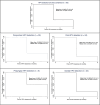Human Papillomavirus Persistence, Recurrence, and Incidence in Early Childhood
- PMID: 40366124
- PMCID: PMC12349960
- DOI: 10.1093/infdis/jiaf213
Human Papillomavirus Persistence, Recurrence, and Incidence in Early Childhood
Abstract
Background: Little is known on the vertical transmission of human papillomavirus (HPV) and on the dynamics of HPV among children. Our objective was to determine the risk of HPV recurrence, persistence, and incidence over 2 years of age among children born to HPV-positive mothers.
Methods: We conducted the HERITAGE study among pregnant women recruited between 2010 and 2016 in Canada. HPV DNA testing was done on vaginal samples collected during the first and third trimesters of pregnancy, and on conjunctival, oral, pharyngeal, and genital samples collected in children from birth and at every 3-6 months up to 2 years. We estimated the probability of HPV vertical transmission, and of HPV recurrence, persistence, and incidence among children during follow-up. Time to clear HPV among children was estimated using Kaplan-Meier technique.
Results: Among the 422 women with HPV during pregnancy, 390 carried pregnancy to term, and 395 children were born alive including twins/triplets. HPV vertical transmission was estimated at 7.3% (95% confidence interval [CI], 5.0%-10.4%) with a genotype concordance of 85.2%. During the entire follow-up, we observed 91 HPV detections (among 51 children) including 2 recurrent and 1 persistent. Incident genotypes occurred in 26 of the 270 (9.6%) children with valid HPV testing during follow-up. Most HPV infections detected in children cleared with a mean time of 3.9 months (95% CI, 3.6-4.2 months).
Conclusions: HPV vertical transmission and incident HPV occasionally occur during infancy, but the risk of persistence or recurrence is overall very low.
Keywords: children; human papillomavirus (HPV); persistence; pregnancy; recurrence.
© The Author(s) 2025. Published by Oxford University Press on behalf of Infectious Diseases Society of America.
Conflict of interest statement
Potential conflicts of interest . F. C. has received funds to evaluate novel HPV detection tests through his institution, the research center of the CHUM, and from Becton-Dickson and Roche Molecular Systems. H. T. has received occasional lecture fees from Merck and unrestricted grants from ViiV Healthcare. All other authors report no potential conflicts of interest. All authors have submitted the ICMJE Form for Disclosure of Potential Conflicts of Interest. Conflicts that the editors consider relevant to the content of the manuscript have been disclosed.
Figures


Similar articles
-
Human Papillomavirus Transmission and Persistence in Pregnant Women and Neonates.JAMA Pediatr. 2023 Jul 1;177(7):684-692. doi: 10.1001/jamapediatrics.2023.1283. JAMA Pediatr. 2023. PMID: 37213128 Free PMC article.
-
The Utility of an Human Papillomavirus Genotype Assay for Cancer Screening in Self-Collected Urine and Vaginal Samples from Japanese Women.Gynecol Obstet Invest. 2025;90(2):143-152. doi: 10.1159/000541641. Epub 2024 Oct 7. Gynecol Obstet Invest. 2025. PMID: 39374596 Free PMC article.
-
Prophylactic vaccination against human papillomaviruses to prevent cervical cancer and its precursors.Cochrane Database Syst Rev. 2018 May 9;5(5):CD009069. doi: 10.1002/14651858.CD009069.pub3. Cochrane Database Syst Rev. 2018. PMID: 29740819 Free PMC article.
-
Immersion in water during labour and birth.Cochrane Database Syst Rev. 2018 May 16;5(5):CD000111. doi: 10.1002/14651858.CD000111.pub4. Cochrane Database Syst Rev. 2018. PMID: 29768662 Free PMC article.
-
Genotype distribution of human papillomavirus among women with cervical cancer stratified by HIV status in Tanzania.PLoS One. 2025 Aug 1;20(8):e0322311. doi: 10.1371/journal.pone.0322311. eCollection 2025. PLoS One. 2025. PMID: 40748896 Free PMC article.
References
-
- Medeiros LR, Ethur AB, Hilgert JB, et al. Vertical transmission of the human papillomavirus: a systematic quantitative review. Cad Saude Publica 2005; 21:1006–15. - PubMed
-
- Syrjänen S. Current concepts on human papillomavirus infections in children. APMIS 2010; 118:494–509. - PubMed
-
- Weinberg M, Sar-Shalom Nahshon C, Feferkorn I, Bornstein J. Evaluation of human papilloma virus in semen as a risk factor for low sperm quality and poor in vitro fertilization outcomes: a systematic review and meta-analysis. Fertil Steril 2020; 113:955–69.e4. - PubMed
Grants and funding
LinkOut - more resources
Full Text Sources

